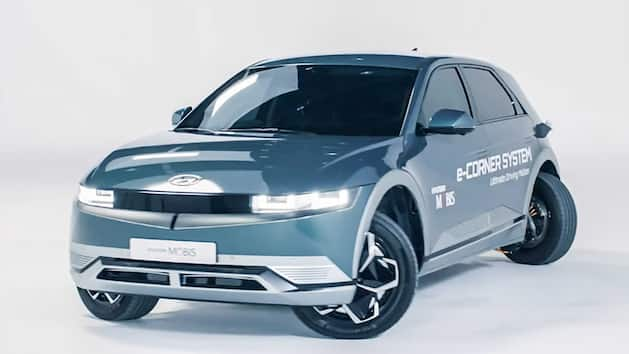Hyundai Mobis is Korea’s largest auto parts supplier, and as the name suggests, the company is owned by the Korean automaker. However, it not only deals with individual parts, but also with autonomous driving and other technology. At the CES electronics fair, Hyundai Mobis now showed a vehicle with insanely twisted wheels. You can see the video about it here.
The prototype is based on four so-called “e-corner modules” that were installed in a Hyundai Ioniq 5. The technology was already presented in 2018, as reported by InsideEVs.com. But now the Korean company has apparently made significant progress. The video above shows what the car can do.
If all four wheels are placed at right angles to the direction of travel, the trolley can drive sideways. Of course, this crab drive (crab drive) makes parking a lot easier, because you could drive in and out of a parallel parking space at a right angle.
If the wheels are turned inwards by about 45 degrees in opposite directions, the car can turn on the spot – i.e. perform a so-called tank turn. If, on the other hand, the wheels are turned in the same direction by 45 degrees, diagonal driving is possible.
Hyundai Mobils also shows a pivot turn, in which the car rotates around a front wheel like a hinged door. The front wheels are straight while the rear wheels are turned 90 degrees.
Each e-corner module consists of an electric motor, a wheel suspension including an electric damper (probably an electrically controlled damper) as well as brakes and steering. The latter have by-wire technology (brake by wire or steer by wire), i.e. there is no physical connection between the brake pedal or steering wheel on the one hand and the wheels on the other, the control is electronic.
The motor is not positioned exactly in the center of the wheel on the axle, but slightly offset. Nevertheless, Hyundai describes the principle as an in-wheel motor – but it is probably not a wheel hub motor in the strict sense. The module is said to be suitable for all kinds of electrified all-wheel drive models – in addition to battery electric vehicles (BEVs), also for fuel cell vehicles (FCEVs) and even hybrids (HEVs).
In addition to the high level of maneuverability, the layout enables torque vectoring thanks to the electric motors that can be controlled individually for each wheel, which is intended to improve cornering dynamics. In addition, power consumption should be reduced. It also simplifies the design of electric vehicles – especially when it comes to scaling.
Rear-wheel steering is already commonplace in the automotive industry, but most models only allow small steering angles. For example, Mercedes equips its EVA2 models (i.e. EQE, EQE SUV, EQS and EQS SUV) with rear-wheel steering with a maximum of 10 degrees.
The Mercedes EQG and the GMC Hummer EV offer larger steering angles. BYD has also just introduced two electric cars that can complete the tank turn.
InsideEvs.com also found two videos from the early days of the automobile showing a similar technique. The first video shows a classic car with the front wheels fully inwardly turned in opposite directions, allowing the car to get in and out of the parking space more easily by pivoting a rear wheel.
Another video shows another invention where a fifth wheel could be lowered to the ground at the rear. This lifted the rear wheels and the whole rear part of the car into the air. A pivot turn around a front wheel was possible, which should make parking easier:
This article was written by Stefan Leichsenring
The original of this post “Prototype can turn wheels by up to 90 degrees” comes from InsideEVs.de.
On our e-mobility portal EFAHRER.com you will find all e-vehicles available on the German market
You can also arrange a test drive for the car of your choice free of charge and thus start e-mobility in an uncomplicated manner.















